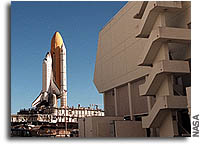NASA Responds to the Columbia Accident Report: Schedule

Schedule pressure
One of the problems cited by the CAIB had to do with schedule pressure – and how this may cause critical tasks to be compromised. Adm. Gehman said that ‘every manager – to a person – said that there was no schedule pressure – yet if you go to the worker bee level, to a person, they say there was a lot of pressure. There was a complete miscommunication as to what the truth was.”
Prior to the Columbia accident, NASA management, Sean O’Keefe in particular – would make constant mention of the March 2004 milestone for the launch of Node 2 and the attainment of U.S. Core Complete – and how everyone was working towards that specific milestone. Milestones are found within schedules, and in order to achieve that milestone, one would have to adhere to a particular schedule – one which often left little room to wiggle.
[Note: The last Shuttle schedule before the Columbia accident can be viewed here. A collection of ISS and Shuttle related status reports can be viewed here in reverse chronological order]
O’Keefe now says that NASA has set 11 March 2004 as a “no earlier than” launch date for the next Shuttle mission. Moreover, O’Keefe said there would be yet another driver for the launch date: the ability of the ISS logistics and integration schedules to be met – and a suggestion that there could well be slippage in this date if either driver was not met. O’Keefe said that everyone in the agency needs to know that the schedule is flexible.
You could see some of this mindset in a comment O’Keefe made after he had been to a few Shuttle launch. Pre-launch weather reports regularly phrased weather conditions in terms of the percentage chance that this or that condition would preclude launch i.e. how much of a safety risk this was. O’Keefe wondered aloud, and even said that he had given direction to Shuttle Program to start stating these forecasts in a more positive light i.e. the chance that these conditions will allow a launch to occur.
If NASA were to be adhering to the new safety ethos promoted by O’Keefe i.e. that it is incumbent upon the program to prove something is safe (not that it isn’t safe), then one would want the risk of precluding launch to be stated just the way it was – i.e. the chance that something might happen – not the chance that it would not. Its not the things which do not happen which turn around and bite you – rather, it is the things that do happen – like foam strikes.

Milestones
NASA has a practice of working towards specific milestones – such as a launch date. Without having an agreed to point at which a variety of tasks need to be accomplished, you’d have programmatic chaos with everyone working to a different timeline – with processes that have specific and interlinked sequences totally out of synch. Sometimes things proceed toward a specific deadline even when there is some growing doubt that the date can be met. The logic being that you strive to get the system as close as you can to meeting the established date – and wait and see what prevents you from doing so. Then you slip the date. Sometimes the working dates can seem wildly optimistic – even implausible. Yet the program keeps working towards that date until program managers provide some ‘schedule relief’.
In late March, a matter of weeks after the accident, NASA was working towards launch dates for the next Shuttle mission of no earlier than 21 July 2003. This target launch date was then slipped to no earlier than 1 October 2003 in early April. It was in April the details of just what NASA was facing start to become very obvious – as seen in the voluminous ISS Monthly Program Review – specifically in the ground rules and assumptions that were put in place to guide the eventual adjustment of planned launch dates.
Slow Down
Some in Congress feel that this current schedule is too optimistic and that it simply rekindles the schedule pressure than many saw as a contributor to many of NASA’ problems in the first place. The suggestion was made by some members of Congress that this date be relaxed somewhat – but no specific amount of relaxation was suggested. Last month House Science Committee Chair Sherwood Boehlert (R-NY) went one step further and said “I think it’s going to be largely guided by what we say and, obviously, the feelings expressed at 1600 Pennsylvania Avenue. I think quite frankly we’re in the driver’s seat, as we should be, on determining that.”
Clearly the launch date will be set according to the ability of NASA to implement the recommendations of the CAIB report. It is certain to have a lot of eyes looking over it shoulder as it does. If NASA has learned its lessons well, a series of checks and balances will be in place that will alert NASA to potential problems with a certain launch date in a way such that either tasks can be adjusted or launch dates slipped.
It is certainly important for Congress to have oversight into how NASA is reacting to things. But if Congress starts to think that they know when and how to fly Space Shuttles better than NASA does, this will only serve to create more problems than it solves. If the CAIB’s recommendations are properly implemented, the process itself will send out warning signs.








